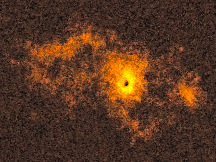The most-detailed computer simulations of a black hole to date have finally confirmed the innermost regions of a hole’s accretion disc – the surrounding gas and dust that orbit the singularity and eventually fall in – is aligned with the hole’s equator. While that might seem apparent, it took more than four decades to convincingly resolve.
Computational astrophysicists from Northwestern University, the University of Amsterdam and the University of Oxford accomplished the feat using graphical processing unites, or GPUs, to more efficiently process huge amounts of data.
The team found that while the outer regions of an accretion disc can remain tilted, the innermost region aligns with the black hole’s equator with a smooth “warp” connecting the two regions. In 1975, Jim Bardeen and Jacobus Petterson argued that a spinning black hole would result in the inner region aligned with the equatorial plane, exactly what the computer simulations revealed.
“This groundbreaking discovery of Bardeen-Petterson alignment brings closure to a problem that has haunted the astrophysics community for more than four decades,” said Northwestern’s Alexander Tchekhovskoy, a co-leader of the new research. “These details around the black hole may seem small, but they enormously impact what happens in the (host) galaxy as a whole. They control how fast the black holes spin and, as a result, what effect black holes have on their entire galaxies.”
Matthew Liska, a researcher at the University of Amsterdam and first author of a paper outlining the results, said the simulations “not only solve a 40-year-old problem, but they have demonstrated that, contrary to typical thinking, it is possible to simulate the most luminous accretion disks in full general relativity.
“This paves the way for a next generation of simulations, which I hope will solve even more important problems surrounding luminous accretion disks.”

Black holes cannot be directly observed because their concentrated gravity prevent radiation from escaping. But gas in an accretion disc gets heated to enormous temperatures as it spirals around a black hole, radiating across the electromagnetic spectrum and giving astronauts a direct look at the effects of the hole’s gravity.
Accretion discs control how fast a black hole grows and how fast it spins.
“Alignment affects how accretion disks torque their black holes,” Tchekhovskoy said. “So it affects how a black hole’s spin evolves over time and launches outflows that impact the evolution of their host galaxies.”
Until now, simulations have been too simplified to pin down the Bardeen-Petterson alignment for two primary reasons. Close to a black hole, material in the accretion disc is moving at higher and higher relativistic velocities in an environment where the hole’s rotation is warping the fabric of space-time. In addition, magnetic effects play a role.
Liska and Tchekhovskoy developed new computational techniques that allowed them to model an extremely thin accretion disc, one with a height-to-radius ratio of 0.03. They immediately saw the predicted alignment next to the black hole.
“The thinnest disks simulated before had a height-to-radius ratio of 0.05, and it turns out that all of the interesting things happen at 0.03,” Tchekhovskoy said. “Nobody expected jets to be produced by these disks at such slight thicknesses. People expected that the magnetic fields that produce these jets would just rip through these really thin disks. But there they are. And that actually helps us resolve observational mysteries.”
The simulations were carried out using the Blue Waters supercomputers at the U.S. National Center for Supercomputing Applications at the University of Illinois at Urbana-Champaign.



